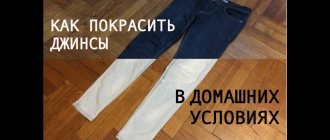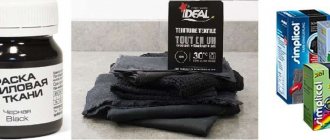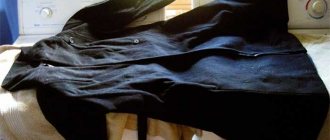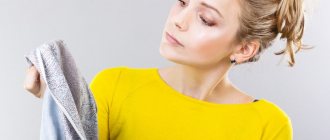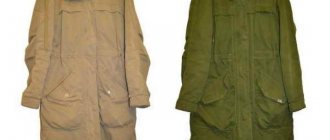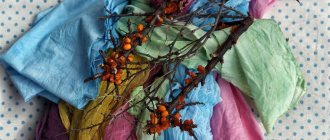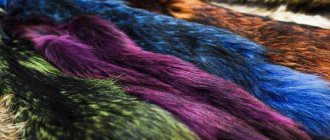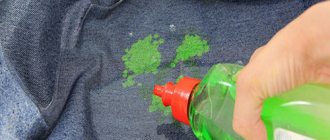Date: 10/24/2017
What to do if you don’t want to part with your favorite things, but they have already lost their original appearance and become faded? There is only one way out; they can be repainted. The question is especially often asked on forums: how to dye jeans in a washing machine? This procedure scares some housewives, but it is worth saying that there is nothing complicated about it. The main thing is to choose the right paint for dyeing clothes and follow all the recommendations indicated on the packaging with the coloring composition.
What fabric can be dyed?
Before you start dyeing, try changing the shade on a piece of fabric of the same quality.
The most difficult things to dye are things made of nitron or lavsan. You can take such a desperate step if otherwise the item is simply impossible to wear.
Before painting, wash the clothes you just bought. Some manufacturers apply a special composition that protects against fading. To change the shade, you need to rinse things in a solution of a synthetic detergent.
- Mix 50 g of ammonia at a concentration of 25% in 10 liters of water.
- Soak and rinse the selected clothing.
- Rinse in clean water.
It is more difficult to tidy up clothes that have faded spots or dirt stains. Dirty areas can reappear after painting, so they need to be washed. The quality of dyeing used clothing depends on the required shade.
If you want to get a lighter tone than before, even out the tone further. If the overall color is darker than the original color, the faded spots will become invisible.
Fabrics made from natural fibers lend themselves best to dyeing. If you decide to redye something made of synthetic material, try to find special dyes that have a strong effect. There are certain requirements for the material that is being prepared for painting:
- A juicy, clean shade will turn out on white or any light-colored items.
- Cotton, muslin, silk or wool lend themselves better to dyeing with natural dyes.
- Cotton, wool, rayon, linen, ramie and nylon respond better to artificial dyes.
- For items consisting of 60% dyeable threads, it is better to use chemical dyes. Since the rest of the fibers cannot be dyed, the final color will be less saturated.
Items made of metalized threads, elastane and items with a “dry clean only” symbol on the tag cannot be painted.
Dye for dyeing clothes
In order to dye clothes at home, you need to choose a suitable paint. The most important thing to consider is the type of fabric. If you are not sure what fabric the clothes are made of, then purchase universal dye. Let's look at the most common dyes.
- Surf dye is a universal dye suitable for natural and artificial fabrics such as cotton, wool, nylon. The palette of this dye includes 10 colors. One packet of paint is designed to dye 0.5 kg of fabric.
- Paint under the Simplicol brand is a paint intended for dyeing natural fabrics, as well as clothes consisting half of synthetics. Manufacturers of the dye warn that it is not suitable for dyeing wool, silk, cashmere, polyamide and polyurethane-coated clothing. There is a special dye marked for silk and wool. Note that this paint, unlike the previous one, contains a dye fixative. It is suitable for dyeing in the washing machine.
- Paint under the Fashion Color brand is a fabric paint made in Germany, suitable for dyeing items in the washing machine. One package of paint is enough for 1.5 kg of clothes.
Important! The paint color declared by the manufacturer will be original only when dyeing white clothes; in other cases the tone will be different.
Preparatory activities
Since the dye can stain the floor and furniture, it is necessary to cover the problem areas with film or paper, placing them in 2-3 layers. Prepare dish sponges or paper towels in advance. You will need them if you accidentally spill dye.
Any clothing must be washed before repainting. Paint only clean items, otherwise the paint will apply unevenly. To wash, dilute a soap solution with warm water and.
To get a richer shade, lighten your clothes using bleach. After washing, start dyeing immediately. The dye spreads evenly onto the damp fabric.
Important Tips
Before you begin the procedure of dyeing things, you need to study the list of recommendations.
- First you need to carefully weigh the pros and cons. You need to understand that when dyeing clothes amateurishly, expectations and reality can be radically different.
- You need to know exactly the composition of the fabric. It is not uncommon for the composition stated on the label to be completely untrue.
- You need to decide exactly what color you want. You can dye it in colors that are slightly darker than the original color of the item. The final result can be assessed objectively only after the clothes have completely dried, since the color of wet clothes is slightly darker. If the shade of the diluted paint does not inspire confidence. It’s better not to take risks, as you can permanently damage the item. In industrial conditions, paints are tested many times before dyeing fabric. With amateur coloring, there is only one attempt.
- It is advisable to test the paint on a small piece of fabric of similar composition. In this case, you can understand what result to expect.
- When painting things, you need to wear old clothes. Have a wet cloth ready in case the paint spills.
- If the dye is in powder form, then it is first diluted in water and then filtered through a couple of layers of gauze.
- It is necessary to work with rubber gloves so as not to get your hands dirty.
To get a good result, you must strictly follow the instructions on the paint package.
It is worth considering that things fade a lot after painting. The water stains the most during the first wash, then the shedding decreases with each wash.
When working with paint, you should not inhale its vapors, as this can lead to severe allergies. The room in which things are dyed must be well ventilated.
How to use natural dyes?
Selecting a retainer.
Fixatives are necessary to ensure that the paint adheres better to the fibers. They differ and depend on the type of paint chosen:
- Natural paints made from berries are fixed with a fixative made from saline solution. To prepare it, you need to use 100-125 ml of salt and 8-9 glasses of cold water. Mix the salt thoroughly until completely dissolved.
- Dyes from onion peels and herbs are fixed with vinegar fixative. To prepare it, take 500 ml of white vinegar and 2 liters. cold water.
For chemical dyes, special fixatives are sold that are suitable for the type of material.
For the fixative to work, soak the item in it and leave for 60 minutes. After this, rinse the clothes under running cold water.
What and how is natural dye made from?
You can create a dye from natural material yourself. You need to collect plant material from which you will create your own shade. To make the shade rich and colorful, you should follow the collection rules:
- collect nuts in ripe form;
- berries, fruits and vegetables must ripen;
- If you are picking flowers, they should already be in bloom. It is better if, in terms of development, they are located closer to the final period of life;
- Collect stems and leaves in full growth.
Grind the collected herbarium into small pieces using a kitchen knife or a coarse grater. Grinding the vegetation allows the color pigments to be released. This way they end up in the water faster. Place the prepared parts of the plant in a large saucepan. The volume of the container should exceed the volume of vegetation by 2 times.
Pour in water to cover the cooked vegetables by half and set over high heat. Keep the pan over high heat until it boils. As soon as the mixture begins to bubble, turn the heat to low and let the mixture sit for about 1 hour. The mixture should simmer over low heat.
Cool the mixture to such a temperature that you can strain it. Use a sieve for these purposes. Pour the separated liquid back into the pan.
How to choose the right color?
You can make many different shades from natural materials, you just need to know which berries, herbs or vegetables give the color.
Here are the common colors that you can get from natural substances that are found in every housewife's kitchen or garden.
Red with a hint of brown
- get it using pomegranate, beets, elderberries and dried hibiscus flowers.
Red with a hint of purple
obtained from blueberries, herbs - basil and purple daylily flowers.
Brown color
can be obtained from a decoction of oak bark, dandelion roots, walnut shells, acorns, and goldenrod sprouts. To obtain the same shade, tea leaves and coffee are used.
Purple with blue tint
obtained from the squeeze of red cabbage, dogwood bark, cornflower petals, purple mulberries, blueberries, grapes and purple iris.
Pink is created
from cherry, strawberry, raspberry juice and fir bark.
To obtain a bright orange natural dye, use onion peels, plantain or golden lichen seeds, and carrots.
Juicy yellow color
obtained from alfalfa seeds, laurel leaves, St. John's wort flowers, calendula, dandelion, narcissus, turmeric and paprika.
Green tint
It is created from the squeeze of sorrel rhizomes, spinach leaves, and snapdragons. Flower heads of lilac and yarrow are used. Artichoke and yarrow plants are also used.
Shades from the color palette from gray to black can be obtained using blackberry juice in different concentrations, decoctions from the shells of walnuts, California ink.
How to paint?
You should not wait until the finished solution has cooled completely. Place the selected item and lower it into the pan. Turn on the heat and keep on medium heat. The gas should be turned off the moment the item reaches the desired shade.
There are a few things to consider:
The color looks brighter when wet than when dry. As soon as the clothes dry, their shade loses some brightness.
- On average, it is necessary to keep clothes on medium heat for 40 to 60 minutes.
- To get bright, rich colors, boil things in a saucepan for at least 8 hours. You can keep things for up to 12 hours.
- To ensure an even color, stir the clothes in the pan regularly.
- After painting, wash clothes in cool water and separately from the bulk of your items. You can dry it either in a dryer or in an open space.
How to paint with chemical dyes?
When painting with chemical dyes, the fixing agent is added to a container of boiling water. There are several types of fixatives that are suitable for certain fabrics:
- silk, cotton and other natural fabrics - 1/4 ml of salt per 6 liters of water;
- nylon and other synthetic threads - 1/4 ml of white vinegar per 6 liters of water.
To dye things, take a large pan so that things can be painted freely. On average, for 1 item, use a container with a volume of 7-8 liters.
Pour 5-6 liters of water and place over medium heat until it boils. As soon as the water begins to bubble, add fixative and dye. There are 2 forms of dyes on sale:
- liquid;
- granules.
When purchasing, pay attention to the label. It should contain instructions with the sequence of application. It also indicates how much paint needs to be added to the pan.
Powdered paint is most often poured completely into the pan. Liquid dye is added in measures (usually 6 liters - half a bottle). Stir the paint thoroughly so that there are no lumps left. After the dye has completely dissolved, lower the clothes.
Try to ensure that the item is completely immersed and evenly saturated with the coloring composition.
Once the water completely covers the clothes, let it boil. Once boiling, turn down the heat so that the water boils but does not splash. Simmer over low heat for 30-40 minutes, stirring occasionally. There is no need to cover the container with a lid.
Carefully pull out hot items with two forks and place them in a container where you can rinse under running water. Alternatively, transfer them to the bathtub or sink. During rinsing, dye leaks out of items, this is normal.
Rinse until they stop staining. Rinse with hot water, switching it to cold mode. When cold it is an excellent fixative. After dyeing with chemical dyes, hang dry the items.
Tumble drying is contraindicated. If you dry indoors, place a rag on the floor that you don’t mind throwing away. The fact is that drops can stain surfaces.
The procedure for dyeing clothes in a washing machine
Before you dye your clothes in the washing machine, you need to wash them well. Only after this do we perform the following steps in sequence:
- Take fabric paint and dilute it according to the instructions. If the dye is liquid, then pour the required amount into a measuring container.
- Pour the paint into the powder tray.
- Place the wet clothes (jeans, coats or T-shirts) that you want to dye into the drum. Wet things stain better.
- Depending on the model of the washing machine, we select a washing mode in which the water in the drum is heated to a temperature of 90-950C. The washing time should be at least 30 minutes. You can read more about possible functions in the article Functions and modes in a washing machine
Note! Longer washing will provide better dyeing of the fabric, its color will be more saturated.
- You can set an additional rinse to ensure that the excess dye is thoroughly rinsed out of the clothes.
- We start the wash and wait.
- Now we select the washing mode in cold water and wash the dyed clothes with powder. Cold water will set the dye into the fabric. You can rinse the item by hand, but be sure to use cold water.
- At the end of the procedure, the washing machine must be cleaned of paint. To do this, start the washing process with the addition of one glass of bleach. You can put old and unnecessary things. If there are none, then you need to start the car in idle mode. This procedure is done so that the remaining dye particles are washed out of the machine and do not spoil the items during the next wash.
So, the item is painted, all that remains is to dry it, and you can put it on again.
Does paint harm the washing machine?
Having heard that clothes can be dyed in a washing machine, some may wonder what will happen to the machine after such a procedure. The question is quite reasonable, let's try to answer it. After the usual procedure of dyeing clothes with fabric dye, nothing will happen to the machine, since the dyes do not contain aggressive chemicals. It is much more dangerous to pour vinegar or other acids into the car, which can lead to the destruction of rubber parts.
But it's not that simple. After such a procedure, paint particles may remain in the machine, which will require additional cleaning and rinsing. If you neglect this, then after the next wash you can remove stained items from the machine. That’s why it’s worth washing something you don’t need in it at least once.
Dyeing jeans and fabrics in a machine has a big advantage. You don’t have to constantly stir and turn the product with your hands when working with paint and boiling water. All this work is done by the technique, thereby ensuring uniform coloring. However, the final decision is up to you on how to dye your jeans in a washing machine or in a basin.
How to dye cotton and linen items with direct dyes?
Pour the powder into a container and add warm water dropwise to form a smooth paste. Add water to the paste in a ratio of 500 ml per 1 liter of water. Stir the mixture and strain through a cloth.
After this, dilute the finished solution with water at 40-50 degrees so that the diluted dye is 10-20 times larger in volume than the volume of the items. Dip things into the prepared solution and leave until boiling. After 20 minutes of low boiling, remove the items and pour in 2 liters of prepared saline solution (2 liters of salt per 2 liters of water).
If the finished color should be light, reduce the amount of salt by 2 times.
Lower the items and simmer for another 35 minutes. Remove the container from the heat and let it brew for another 35 minutes. Turn the garment over throughout the entire procedure to ensure even dyeing.
